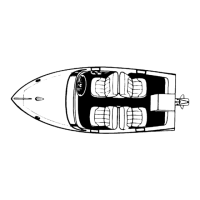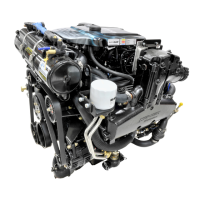GENERAL INFORMATION - 1A-590-823225--1 1096
For best speed and minimum spray, the corner be-
tween the bottom and the transom should be sharp.
72003
a - Flat
b - Sharp Corner
The bottom is referred to as having a “hook” if it is
concave in the fore-and-aft direction. A hook causes
more lift on the bottom near the transom and forces
the bow to drop. This increases wetted surface and
reduces boat speed. A hook, however, aids in planing
and reduces any porpoising (rhythmical bouncing)
tendency. A slight hook is often built in by the man-
ufacturer. A hook also can be caused by incorrect
trailering or storing the boat with support directly un-
der the transom.
72004
a - Hook
A “rocker” is the reverse of a hook. The bottom is convex
or bulged in the fore-and-aft direction. It can cause the boat
to porpoise.
72005
a - Rocker
Any hook, rocker or surface roughness on the bot-
tom, particularly in the all-important center-aft portion
will have a negative effect on speed, often several
miles per hour on a fast boat.
Marine Fouling
Fouling is an unwanted build-up (usually animal-veg-
etable-derived) occurring on the boat’s bottom and
drive unit. Fouling adds up to drag, which reduces
boat performance. In fresh water, fouling results from
dirt, vegetable matter, algae or slime, chemicals,
minerals and other pollutants. In salt water, bar-
nacles, moss and other marine growth often produce
dramatic build-up of material quickly. Therefore, it is
important to keep the hull as clean as possible in all
water conditions to maximize boat performance.
Antifouling paint, if required, may be applied to boat
hull observing the following precautions.
IMPORTANT: DO NOT paint anodes or MerCa-
thode System reference electrode and anode, as
this will render them ineffective as galvanic cor-
rosion inhibitors.
!
CAUTION
Avoid corrosion damage. Do not apply antifoul-
ing paint to MerCruiser drive unit or transom as-
sembly.
IMPORTANT: If antifouling protection is required,
Tri-Butyl-Tin-Adipate (TBTA) base antifouling
paints are recommended on MerCruiser boating
applications. In areas where Tri-Butyl-Tin-Adi-
pate base paints are prohibited by law, copper
base paints can be used on boat hull and boat
transom. Corrosion damage that results from the
improper application of antifouling paint will not
be covered by the limited warranty. Observe the
following:

